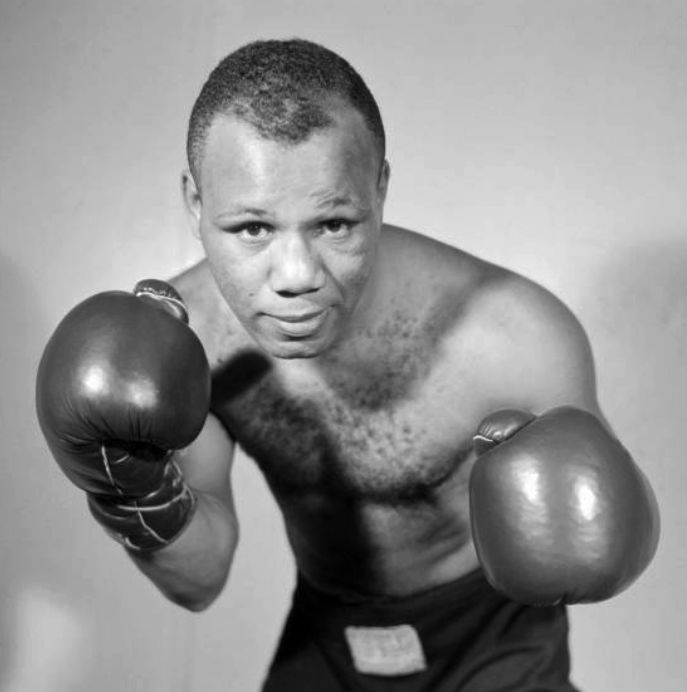1950s TV Darling Ralph “Tiger” Jones
By Dan Cuoco
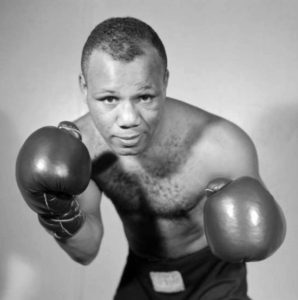 Ralph “Tiger” Jones was born Ralph Josiah Jones in Brooklyn, New York, on March 14, 1928. He was a 5′ 8″, powerfully built boxer who fought in a bobbing and weaving style, constantly moving forward and throwing punches with both hands. Aided by a granite chin, he was only stopped once, on a cut eye, in eighty-nine professional fights against his era’s top welterweights and middleweights. Between February 1953 and August 1960, Ring magazine ranked him as high as the number three middleweight in the world. He never received a world title shot because of upset losses to lesser-named opponents at the most inopportune times during his career.
Ralph “Tiger” Jones was born Ralph Josiah Jones in Brooklyn, New York, on March 14, 1928. He was a 5′ 8″, powerfully built boxer who fought in a bobbing and weaving style, constantly moving forward and throwing punches with both hands. Aided by a granite chin, he was only stopped once, on a cut eye, in eighty-nine professional fights against his era’s top welterweights and middleweights. Between February 1953 and August 1960, Ring magazine ranked him as high as the number three middleweight in the world. He never received a world title shot because of upset losses to lesser-named opponents at the most inopportune times during his career.
Tiger Jones was a fixture of televised boxing in the 1950s because of his aggressive fan-friendly style. He engaged in forty-five national and an estimated twenty regionally televised fights. His overall record was 52-32-5 (KO 13/TKO by 1). He earned the nickname “Tiger” because he was the type of fighter old-timers always talk about, that is, a rugged, rushing scrapper – always moving in with fists swinging, shaking off punches he couldn’t avoid, and delivering a barrage of his own, never holding or backing away.
Ted Carroll wrote in 1956: “Tiger Jones will never be ranked with Harry Greb or Stanley Ketchel, but he didn’t become a hero of the TV lanes fighting soft touches. Future generations, noting the number of losses in his record, may incorrectly infer that he was a toothless tabby cat, yet the names on the list tell another story. They were the top-notchers of the time.”
Before he turned professional in 1950, Jones had 25 amateur fights under the management of Bob Melnick and the tutelage of Gil Clancy, who was only six years older than him. Jones credited Clancy with teaching him how to box and turning him from a juvenile delinquent to a solid citizen. “Gil would always hook me up with fighters from the Salem-Crescent A.C., who tried to fight like Sugar Ray Robinson. They used a lot of fancy hand movements and wouldn’t throw punches. And I knew that if you stayed on top of them and didn’t give them distance, you could beat them using a straight jab and a right cross. So when I fought Sugar Ray in 1955, Gil reminded me how we used to beat those guys in the amateurs that tried to imitate him, and it paid off.”
Jones was a New York golden gloves standout from 1946 to 1950 and participated in the 1949 and 1950 National AAU tournaments in Boston, Massachusetts.
Earning his Tiger Stripes
Jones turned pro on May 27, 1950, and was undefeated in his first eight fights, three by kayo, before losing his first fight on a first-round technical knockout due to a cut eye to former victim Henry Burroughs on January 13, 1951. He fought ten more times in 1951, going 8-1-1. He won a six-round decision over Tommy McGowan; lost a six-round decision to Herbie Hayes; kayoed Armand Michaud in the second round; won a six-round decision over Al Niag; won a six-round decision over Ronnie Hopp; won a six-round decision over Shelby Langford; kayoed Roy Carter in the first round; won a ten-round decision over Bob Stecher in Portland, Maine, in his first ten-rounder; fought an eight-round draw with Sal DiMartino; and stopped Phil Rizzo in seven rounds.
In 1952 he fought eleven times, going 7-3-1. He fought an eight-round draw with Bobby Lloyd in New York; won an eight-round decision over Bobby Lloyd in a return match in Brooklyn; won a six-round decision over Tommy Bazzano in Brooklyn; lost a close eight-round decision to Rocky Castellani in Brooklyn; won an eight-round decision over Tommy Bazzano in a return match in White Plains; won an eight-round decision over Mike Koballa in Brooklyn; lost a close eight-round decision to Jimmy Herring in Brooklyn; won an eight-round decision over Sal DiMartino in Brooklyn; lost a ten-round split-decision to Johnny Saxton by the matter of two points in his first regionally televised fight in New York; won an eight-round decision over Mike Koballa in Syracuse; and closed out the year winning a major upset decision over top-rated welterweight contender Johnny Bratton in his first ten-round main event at Madison Square Garden.
The Bratton fight was televised before a huge nationally televised audience on December 5, 1951, when Tiger first gained the national attention of fight fans with his fan-friendly style. It also vaulted him into Ring magazine’s world middleweight ratings at number ten.
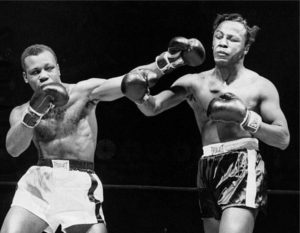
With his father and grandfather at ringside, Jones, a 4-1 underdog, forced the fight from start to finish. He stayed on top of Bratton, refusing to let him get set or angle his deadly long-range punches from outside. The bout was bitterly contested and tense all the way. Jones won the first four rounds, darting left jabs and hooks into Bratton’s face. In the second, third, and fourth, he outpunched Bratton in torrid exchanges and had him in serious trouble with hammer-like right-hand punches. Jones slowed down a bit in the fifth to save energy but was still waging a rugged, aggressive battle with swinging lefts and battering rights. This allowed Bratton to find more openings in the middle rounds, and he made his best showing. In the eighth, Bratton landed a terrific right to the jaw that shook Jones badly, and he pounced on him. However, although he was hurt, Jones fought back furiously, slugging it out with the more experienced Bratton. Jones was still pressing his attack in the ninth and tenth rounds, actually outboxing the bleeding Bratton. Referee Harry Kessler scored it 5-3-2, and Judges Harold Barnes and Bill Healey scored the bout 8-2 and 7-2-1, respectively, for Jones. Jones, at 154 pounds, had a five ¼ weight advantage over Bratton. The defeat ruined Bratton’s possible rich bout with top-ranking middleweight contender Carl (Bobo) Olson that had been in the works.
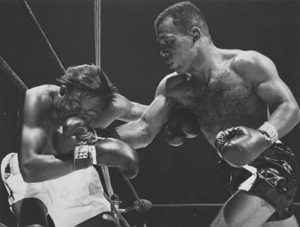
In 1953, Jones entered the ring nine times, going 6-2-1. He lost a ten-round decision to Rocky Castellani in New York; stopped Marvin Edelman in nine rounds in Brooklyn; won a ten-round decision over Danny Womber in Milwaukee; fought a ten-round draw with Womber in Brooklyn; won a ten-round decision over Jimmy Herring in New York; won a ten-round decision over Joe Tomasello in Brooklyn; won a ten-round decision over Mickey Laurent in Brooklyn; ended his trilogy with Womber by winning an easy ten-round decision; and lost a competitive ten-round decision to Kid Gavilan in New York on August 26, 1953.
Following the Gavilan bout, Dr. Vincent Nardiello said x-rays at St. Clare’s Hospital disclosed Jones had suffered a fracture and dislocation of the right thumb. Consequently, Jones was out of action for six months when he had an operation on his broken right thumb and right elbow to remove bone chips. He finished his 1953 ring campaign as Ring magazine’s eighth-ranked world middleweight contender.
In the September 1953 issue of Ring magazine Lew Eskin wrote, “Jones’ two-fisted slam-bang action style has made him a big favorite with TV fans all over the country. He has been on network TV seven times this year, which is more than any other fighter. He has made over 20 appearances on TV, but only 10 have been on nationwide hook-ups.”
The Five Fight Losing Streak
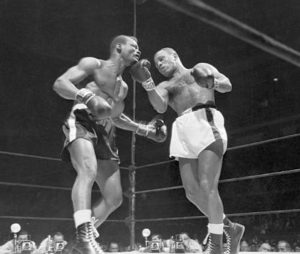
In 1954, Jones entered the ring seven times, going 2-5. On March 8, 1954, he quickly got back into title contention with a thrilling come-from-behind technical knockout of 2-1 favorite Bobby Dykes in 2:12 of the final round of their nationally televised main event at the Eastern Parkway Arena. Trailing on all three scorecards, Jones dropped the fifth-ranking middleweight contender twice with rights to the jaw in the final round. Bobby took nine counts both times, but Referee Jack Watson halted the bout with Dykes out on his feet. A month later, Jones easily won a ten-round decision over Billy McNeece in a nationally televised main event at the Eastern Parkway Arena. The two victories moved Jones to number three in Ring magazine’s world ratings.
Tiger Jones never received a world title shot because of his propensity to lose to lesser-named opponents during his career at the most inopportune times. Back-to-back defeats to unranked underdogs Jacques Royer Crecy and Pedro Gonzales on May 14, 1954, and May 24, 1954, in nationally televised main events from Madison Square Garden and St. Nicholas Arena, proved costly. The losses were catastrophic and immediate. He went from number three in the world ratings in April 1954 and a potential world title shot to be dropped entirely from the top-ten world ratings in May 1954.
His losing streak continued as he lost a ten-round unanimous decision to Joey Giardello in Philadelphia on September 24, 1954, a ten-round split decision to Hector Constance in New York on November 12, 1954, and a ten-round unanimous decision to Peter Mueller in Rochester, New York, on December 4, 1954.
Sugar Ray Robinson
On October 20, 1954, Sugar Ray Robinson announced he would begin training for a comeback. He said he wanted to fight again and win back the middleweight title. When asked if he was returning for financial reasons, he stated that finance is a consideration: “Right now, I weigh 157 ½ pounds…I think dancing has helped my legs…I worked a little in a gymnasium in Europe this summer. I’ll fight anyone who pays me.”
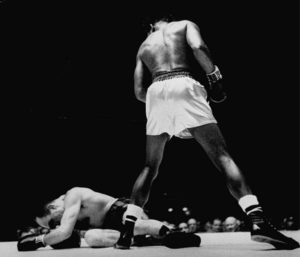
Robinson began his comeback in Detroit on January 5, 1955, against ring veteran Joe Rindone. Robinson was rusty and cautious for five rounds before flashing his old lightning-like form and knocking out Rindone at 1:37 of the sixth round to successfully launch his comeback before a roaring crowd of 11,973 in Olympia Stadium. Robinson told reporters, “I can’t say it was one of my better fights. It’ll take time to regain the touch. The point is I know I still can fight. Five or six more bouts, and then, if all goes well, I want Olson for the title.”
On January 8, 1955, Sugar Ray Robinson’s management team announced that Robinson would meet Tiger Jones at Chicago Stadium on January 19, 1955, exactly two weeks after Robinson’s non-TV return in Detroit and would give a national television audience its first chance to see Robinson since he retired and vacated his middleweight crown in 1952. The International Boxing Club (IBC) chose Jones because he hadn’t won a fight in the past eight months. Moreover, he had lost five fights in a row; in four of them he had been the betting favorite. (So ill-regarded was the opposition that the only top-rated fighter to beat him was Joey Giardello.)
Robinson’s co-manager Joe Glaser had objected strenuously, stating, “This is too soon to go again; you need some rest to build up the strength you’ll have to have. Jones loses fights, but he’s young and will be loaded for you.” Finally, Truman Gibson, secretary of the IBC, jumped in and told Robinson, “I wouldn’t let you fight anybody else. If you don’t take Jones, you lose the date. This guy just walks in, he’s made to order for you, believe me.” Robinson enjoyed hearing Gibson telling him that the public was hungry to see him, and he’d draw the best TV audience in years, and that there hasn’t been anyone to replace him or come close to him. Case closed! Robinson’s ego gave in, and the fight was on.
Ralph (Tiger) Jones was facing the fight with Robinson without illusions. He saw it as an opportunity to use his skill set to cope with fighters with the Robinson technique. “When I was a Golden Glover, we were always in tournaments when we’d come up against fellows from the Salem-Crescent A.C., Ray’s old club. He was the best to have come out of there. Naturally, they all copied him, but soon as they’d come up with a new ‘Robinson,’ I’d knock him off. I must have ruined a dozen of them.” As a pro, he beat a reasonable facsimile of Sugar Ray in Johnny Bratton. (Roger Donoghue, Jones’ former stablemate, told reporters, “Jones is the kind of fighter who tears apart fancy guys like Bratton.”)
Yet questions remained about Jones’ ability to beat Sugar Ray when fighters like Rocky Castellani’s off-beat cleverness made him look terrible. Moreover, what was the cause of his five-fight losing streak? His old friend and mentor, Gil Clancy, tried to explain him. “He’s a sensitive kid. He trains like his life depends on it. He puts too much into it and can’t understand why he should fail. And, when he gets off wrong, he broods. He takes a defeat home with him and gets into a mental rut. And nobody can pull him out of it but himself. But he has heart and common sense, and eventually, he gets himself going again when the public least expects it.”
The Fight
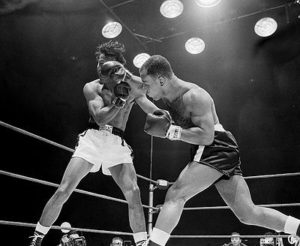
Robinson was an 8-1 favorite to achieve the second straight victory of his comeback campaign. Jones stalked Robinson from the start. He took Robinson’s best punches and kept boring in to score with solid punches of his own. Robinson had trouble jabbing or hitting him in the first round with right hand shots. Jones kept moving under Robinson’s straight lefts and bobbing and weaving out of reach of his rights. Several times in the round, Jones backed Robinson to the ropes. One of Jones’ lefts drew blood from Sugar Ray’s nose.
In the second round, Robinson attempted to step up the tempo, and Jones answered with a left hook which cut Robinson over the right eye. Sugar Ray came out slugging with both hands in the third round, but Jones blunted his attack by moving his head and following up with lefts to the body and rights to the head combinations.
Jones continued to stalk Robinson effectively during the ensuing rounds, taking Robinson’s best punches and boring in to score with solid combinations. Robinson’s timing was way off, and he was forced to retreat the few times he sought to slug it out. Jones drove Robinson into the ropes and mauled him so severely in the late rounds that Robinson’s arms dangled as if weighted down. The decision was not surprising. All three officials scored it heavily for Jones. Referee Frank Sikora voted 99-94; Judge Ed Hintz, 100-88; and Judge Ed Walsh, 98-89. Jones said, “Robinson only hurt me once – with a hard left in the eighth round. I thought my right eye was going out.”
Tiger Claws his way back to the Top Ten
On February 16, 1955, one month after his upset decision over Robinson, Jones met middleweight champion Carl (Bobo) Olson in a nontitle bout at the Chicago Stadium. Olson boxed masterfully and viciously to win his nineteenth straight victory. Jones tried to carry the fight to Olson, but Olson countered brilliantly and effectively to pile up large margins in every round. Olson beat Jones to the punch all the way, except the few times Jones lashed out with stinging rights to the jaw that jolted the champion. Jones only won one round on the three cards of the officials.
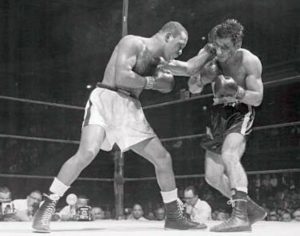
Jones got back in the winner’s column on April 8 with a convincing fifth-round stoppage of Georgie Johnson in St. Louis; on March 13, he lost a ten-round unanimous decision to highly ranked kayo artist Eduardo Lausse at Madison Square Garden. Lausse and Jones wowed the fans with their non-stop, virtually clinchless slugfest. On June 17, he battered tough Ernie Durando into helplessness in the sixth round at Madison Square Garden. Then, on September 23, he hammered out a ten-round unanimous decision over Chris Christensen at the Cleveland Arena. His victories over Durando and Christensen were impressive enough to bring him back into Ring magazine’s world middleweight rankings at number six.
On October 12, he ran his winning streak to three with an impressive ten-round decision over Al Andrews at the Dinner Key Auditorium in St. Louis. Johnny Saxton stopped his modest winning street on November 9, winning a ten-round unanimous decision at the Oakland Auditorium. Jones’ loss to Saxton dropped his year-end ranking to number nine. Once again, because of his aggressive fan-friendly style, all eight of his fights were nationally televised.
In 1956, Jones entered the ring six times, going 4-2. On February 8, he kayoed Tony Baldoni in six rounds in Washington D.C.; on March 23, he won an upset ten-round decision over number two ranked Charles Humez in New York; on April 20, he lost a close ten-round decision to number seven ranked Gene Fullmer in Cleveland; on July 30, he won a ten-round decision over Jesse Turner in Portland, Oregon; on September 14, he won a ten-round decision over Wilfie Greaves in Washington, D.C.; and on November 19, in a rematch with Charley Humez, he lost a ten-round decision in Paris. Despite the loss to Humez, he ended his 1956 campaign as Ring magazine’s third-ranked world middleweight contender.
In and out of the Top Ten Ratings
Between January 1957 and August 1960, Jones was like a yoyo in and out of the world ratings. In 1957, Jones entered the ring eight times, going 3-4-1. On January 18, he won a ten-round decision over Hardy Smallman in Cleveland; on March 25, he won a ten-round decision over Arthur King in Toronto; on April 12, he won a ten-round decision over Chico Vejar in Syracuse; on April 25, he drew in ten rounds with Joe Gray in Flint; on June 7, he lost a ten-round decision to Gene Fullmer in Chicago; on August 24, he lost a ten-round decision to Glen Flanagan in St. Paul; on November 29, he lost a ten-round decision to Willie Vaughn in New York; and on December 27, he lost a ten-round decision to Joey Giardello in Miami Beach. His losses to Fullmer, Flanagan, Vaughn, and Giardello dropped him out of Ring magazine’s world ratings.
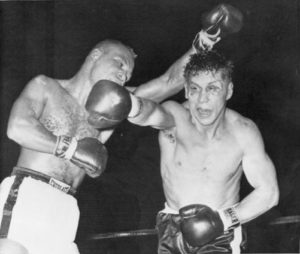
In 1958, Jones entered the ring six times, going 3-3. He split two decisions with Kid Gavilan on February 19 and April 4, winning the first in Miami Beach and losing the second in Philadelphia; on May 17, he lost a ten-round decision to Jimmy Hegerle in Albuquerque; on September 10, he stopped Mickey Crawford in the tenth round in Chicago; and then split two decisions with Rory Calhoun on November 21, and December 15, winning the first in New York and losing the second in Cleveland. He ended his 1958 campaign as Ring magazine’s tenth-ranked world middleweight contender.
In 1959, Jones entered the ring four times, going 2-2. On January 28, he avenged two previous losses to Joey Giardello, winning a ten-round split decision in Louisville; on March 17, now ranked number five by Ring, he lost a ten-round unanimous decision to Paul Pender in Boston; on May 18, Jones lost a ten-round unanimous decision to Joey Giambra in Dallas; on June 26, he won a ten-round decision over Victor Zalazar in New York. Jones ended his 1959 campaign unranked.
Jones Grows Cynical
Jones grew cynical near the end of his career knowing that there was no longer a chance at a title shot. He was quoted as saying, “When a fight is over, I don’t even listen to the decision. It doesn’t matter anymore. If I win, so what?
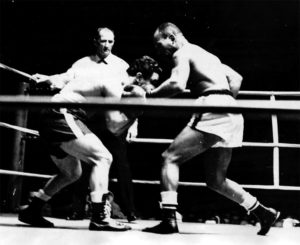
From 1960 through 1962, Jones fought eight times, going 3-4-1. In 1960, he lost a decision to Wilfie Greaves in Chicago, he stopped Willie Greene in seven rounds in Providence, won a decision over Joe DeNucci in Boston, earning him his last entry into Ring’s ratings at number ten, and lost decisions to Marcel Pigou in Boston and Joey Giambra in Buffalo. In 1961, he won a decision over Duane Horseman in Rochester, fought a draw with Joe DeNucci in Boston, and lost a decision to Rocky Fummerelle in Buffalo. In 1962 he lost decisions to Joe DeNucci in Boston and Laszlo Papp in Vienna. His fight with Papp on March 21, 1962, was the last of his career.
After he retired, Jones worked for a canning company and drove a cab. He passed away on July 17, 1994, at 66. He was pre-deceased by his wife of nearly forty years, Dora, and survived by three sons and two grandchildren.
Primary Sources: Ring Magazine, Brooklyn Daily Eagle, New York Daily News, New York Times, Boston Globe, Chicago Tribune, Cleveland Plains Dealer, St. Louis Dispatch, Milwaukee Journal, Newport Daily Express, LA Times, Cincinnati Enquirer, and several online premium databases. I sincerely thank Roger Zotti for his insightful comments.
